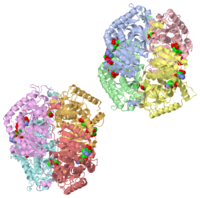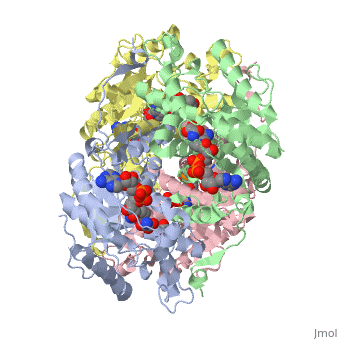Jasper Lactate Final

HUMAN MUSCLE L-LACTATE DEHYDROGENASE M CHAIN, TERNARY COMPLEX WITH NADH AND OXAMATEHUMAN MUSCLE L-LACTATE DEHYDROGENASE M CHAIN, TERNARY COMPLEX WITH NADH AND OXAMATE
Lactate DehydrogenaseLactate Dehydrogenase
Lactate Dehydrogenase (LDH) is an important enzyme in humans. It occurs in different regions of the body, each region having a unique conformation of different subunits. The Jmole image shown is that of LDH-5, the form found in skeleton muscle and the liver.
FunctionFunction

LDH preforms an important metabolic function in the body. The enzyme catalyzes both the conversion of pyruvate to lactose as well as the conversion of lactose to pyruvate. The conversion of pyruvate to lactose occurs in the muscles of the body when oxygen is absent. The lactate acid is then moved back to the liver where LDH catalyzes the Cori cycle which converts the lactose back into pyruvate. The reaction is also important as it is coupled with the interconversion of NADH and NAD+.
CatalysisCatalysis
Studies have shown that the reaction mechanism of LDH follows an ordered sequence. In order for lactate to be oxidized NAD+ must bind to the enzyme first followed by lactate. Transfer of a hydride ion then happens quickly in either direction giving a mixture of the two teranary complexes, enzyme-NAD+-lactate and enzyme-NADH-pyruvate. Finally pyruvate dissociates from the enzyme followed by NADH. The rate limiting step in this reaction is the rate of dissociation of NADH. The same holds true in the reverse reaction that the coenzyme, NADH, must bind first before the substrate, pyruvate, can bind. The conversion of pyruvate to lactate with the subsequent regeneration of NAD+ is a very favorable(1).

Important Sites:
StructureStructure
LDH is comprized of 40% alpha helixes and 23% beta sheets.(2)
SCOP 1I10- a/b Mainly parallel beta sheets (beta-alpha-beta units) 1I0Z- a/b Mainly parallel beta sheets (beta-alpha-beta units)
FormsForms
LDH is a quaternary protein formed of the combination of two subunits, M and H (Muscle and Heart) into a structure of four of the subunits. The various combinations found in the human body are:
- (4H) Heart
- (3H1M) Reticuloendothelial
- (2H2M) Lungs
- (1H3M) Kidneys
- (4M) Muscle and Liver
ReferenceReference
1- http://www.bioc.aecom.yu.edu/labs/calllab/highlights/LDH.htm 2- http://www.cheric.org/ippage/e/ipdata/2004/05/file/e200405-701.pdf

